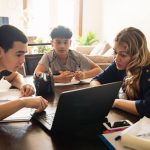Through the help of Zaghi, Hain, Civil Engineering Professor Richard Christenson, Educational Psychology Professor Joseph Madaus, English Professor Tom Deans, and Literacy Education Professor Rachael Gabriel, the team will be developing a strength profiler tool, creating a peer mentoring program, piloting a technical writing program, and holding stakeholder workshops.
Neag School students completing the UConn Administrator Preparation Program (UCAPP) this spring recently presented their capstone projects – the program’s signature final assignment in which students identify a need or opportunity for school improvement and work toward positive change. The UCAPP program went through a redesign in 2020 as part of a nationwide effort known as the University Principal Preparation Initiative (UPPI), funded by the Wallace Foundation. As a result of the redesign, the concept of family and parent engagement became a priority for the first organizational leadership course in UCAPP’s program of study.
This is not the end, it’s the beginning. That was the message from U.S. Secretary of Education Miguel Cardona ’01 MA, ’04 6th Year, ’11 Ed.D., ’12 ELP to UConn’s 2021 graduates, delivered Saturday, May 8 via video during the livestreamed commencement ceremony for all students receiving degrees this year – undergraduate, graduate, and professional.
For Rachael Manzer, a doctoral candidate in the Neag School of Education, life-transformative education takes many forms. Manzer is a five-year volunteer of the UConn 4-H Program, a leader with the Granby 4-H Club, a member of the NASA Network of Astronaut Teachers (NEAT), and a candidate for commercial space flight through Teachers in Space, Inc. In 2019, Manzer received the UConn College of Agriculture, Health and Natural Resources (CAHNR) 4-H Leadership Award, and was recently selected as the 2021 Northeast 4-H Volunteer of the Year Award.
Throughout the academic year, the Neag School is proud to share the latest achievements of its faculty, staff, students, and alumni. Explore their most recent promotions, awards, retirements, publications, and more.
Kiana Foster-Mauro’s mother, grandmother and great-grandmother watched with the 22-year-old elementary education major as she became the first in her family to graduate college. Nadeige Bailey, another first-generation graduate, said she cried on her couch last May as she watched her name flash across her computer screen “for like two seconds.” That was the culmination of her two-year, sports management graduate program.
At Connecticut’s State Education Resource Center (SERC) Dismantling Systemic Racism conference, West Hartford Public Schools Director of Equity Advancement Roszena Haskins was honored with the 2021 George Coleman Excellence in Equity award for her successful and ongoing district-wide work.
.S. Education Secretary Miguel Cardona praised new University of Connecticut graduates for their work in helping to respond to the coronavirus pandemic and urged them to use their uniqueness as their “superpower” to accomplish their career and life goals, in a recorded speech played Saturday at a virtual 2021 commencement. Cardona, Connecticut’s former education commissioner who earned graduate degrees at UConn, taped the speech Friday at UConn’s football stadium in East Hartford, the site of Saturday’s ceremony. The school awarded nearly 8,200 degrees.
“Teachers have new fluency and technology,” says Michael Young, who coordinated the educational technology program at UConn’s Neag School of Education. “Students have new fluency. Society and legislatures have a sense that this is doable now, because we did it for a year.”
The nine-year MLB veteran joined SportsJam host Doug Doyle to talk about the new show, his baseball and broadcasting career, social justice matters, and his days at Teaneck High School. The baseball analyst, writer, author and educator who teaches classes at UConn’s Neag School of Education spoke on a Zoom chat from his home in Bloomfield, Connecticut.


